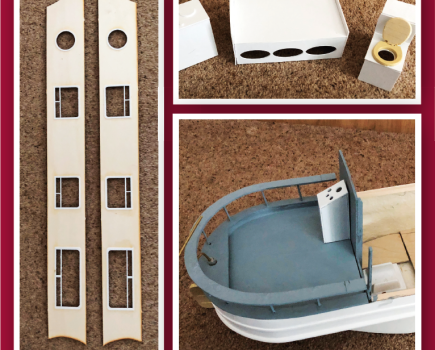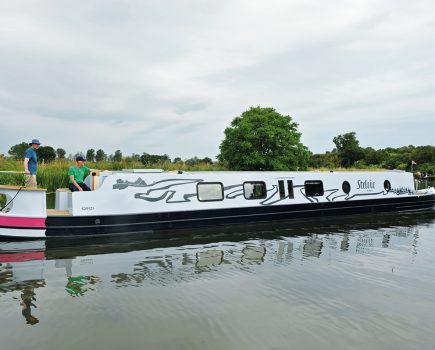Plants can bring an attractive look to your boat as well as being producing tasty food – and looking after them doesn’t have to be a hardship

Living on a boat is different, but it is also great fun and it can be a great way to get back in touch with nature and ecological living. A few compromises have to be made to enjoy the lifestyle, but gardening and growing some of your own fresh food need not be one of them – with a bit of planning, the roof or other parts of the boat can become quite productive places.

Both flowers and vegetables are easily grown on board and, with the popularity of urban gardening, a plethora of plant varieties have been developed to produce very generous crops from smaller and more disease resistant plants, ideal for container gardening. The first consideration is where to put your containers. Safety is an issue here and, in particular, where you have the centre line attached to your boat. If it is a central fixing, it makes sense to keep plants forward of this point to keep the rope free from snagging on anything.

If you can fix a rope each side of your boat, then more space can be freed up for plants. A boat with a cruiser stern may offer more space as does a craft with a longer front deck area. Even some vertical planting can be employed with the use of hanging pouches on the sides, which works well if you fancy growing trailing plants. Having decided on your space, the next thing to think about is containers and growbags. To prevent paint damage, it’s sensible to avoid putting anything either abrasive or moisture-trapping in direct contact with the boat. Trapped moisture can soon lead to paint blistering and rust, possibly resulting in an expensive roof repaint.

Growbags are ideal for rooftop gardening; they are packed with good quality compost and nutrients that will last for several weeks. To protect your paintwork, put one onto a purpose-made tray, available at most garden centres, and then lift it onto a couple of strips of wood or even some rubber door matting to keep the tray slightly elevated, allowing airflow underneath. Alternative containers can be created out of almost anything that will hold a minimum of about 15 cm of compost, has a hole in the bottom to allow for drainage, and is not so high as to create a hazard while cruising under bridges. It’s at this point that you can become as imaginative as you like; from elaborately painted pots to old buckets or boots, from self-watering troughs to recycled tin cans. Plants are not at all fussy; they just need water, compost and a little warmth and sunlight to grow happily.

Container growing does require constant monitoring, though. Always use a good quality all purpose compost preferably containing a slow release fertiliser, or you can add one such as Nutrigel from Gardman, this will feed your plants throughout the season with the gel helping to prevent the compost from drying out. Vegetables are particularly hungry so feeding is essential to ensure a good crop.

Plants on boats are rather exposed to the elements, especially the wind, so keep an eye on watering because leaves tend to deflect the rain away from the roots, so you may think your plants are getting plenty of water but are, in fact, not getting any. River or canal water is fine for flowers, but, I think it is best not used for vegetables because of the risk of waterborne parasites or contaminants.
Even though attention has to be taken with watering and feeding, one great advantage of gardening this way is the easy control of pests and, hopefully, the absence of slugs and snails that can cause so much damage, especially during the seedling stage.
What you actually choose to grow on your boat might depend on how much time you plan to be aboard. If you live on your boat, there is not a month during the year when you can not grow something, and I have seen many boats disguised as veritable floating gardens. If, however, you are spending only the summer onboard, then you might choose a selection of faster growing salad crops and herbs, or some flowers.
I always have flowers on my boat and have had particular success with pelargoniums which just seem to keep on flowering, while the highly scented foliage of the geraniums are said to repel insects. Almost any summer bedding plants will thrive on the boat, though I would avoid the larger flowers such as begonias since they might be a little too fragile and prone to wind damage.
Bedding plants are available as plugs from early spring or as ‘ready to go’ plants from around March. Surfina petunias give a wonderful show and grow in many lovely colours, they flower freely all summer and some varieties also have a beautiful perfume. One could plant a pot with a selection of both flowers and herbs which is practical as well as pretty. I particularly like to grow flowers that give off a perfume in the evening; night scented stock and nicotiana are good varieties – after a day of boating it’s a sheer delight to moor up and enjoy a glass of something with the sweet scent of flowers.
Vegetables are great fun to grow whether you are on a boat or not. Salad crops are fast growing, so radishes, for example, which can be sown from March through to September, only take from four to six weeks to crop. Cut-and-come-again salad leaves, which are often a blend of different lettuces and herbs to give extra flavour and colour, take two to four weeks. Plant successively to ensure a continuous harvest.
Larger vegetables can also do well. Try dwarf or patio varieties of runner and French beans, keep them well-watered and fed and you will have a lovely fresh supply. Self-watering flower pots have a reservoir for water in the base and are particularly good for beans since they do need a lot of water for the flowers to set.
Some of my favourite plants to grow are tomatoes; either started from seed in February and March or bought as young plants in April and May to plant straight outside. There are several fantastic varieties suitable: tumbler varieties do very well such as Tumbling Tom with either red or yellow fruits. Suttons seeds have two excellent dwarf bush varieties, Sweet’n’neat Cherry and Lizzana, both ideal for the boat garden. Or how about a courgette? Mr Fothergill’s seeds have a variety of courgette called Midnight, developed especially for container growing from which I have seen some very good results.
So whatever you plan to grow, follow a few basic rules and your gardening on your boat should thrive through the whole year.
Image(s) provided by:
Archant







